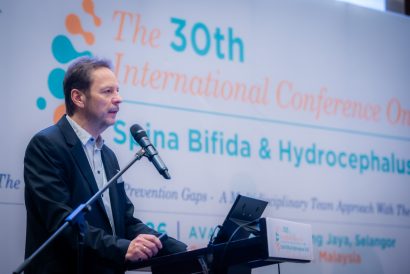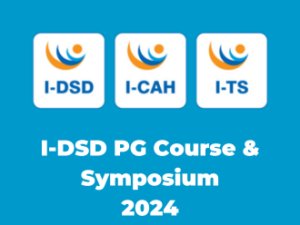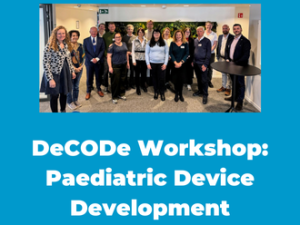Prof. Christian Radmayr, the chair of the Paediatric Urology Guidelines Panel of the European Association of Urology (EAU), attended the 30th International Conference on Spina Bifida and Hydrocephalus in Kuala Lumpur, Malaysia, from 24 to 26 October 2024, where he presented about new collaborative guidelines that ERN eUROGEN has been involved in producing. His report from the meeting follows.
Report from the 30th International Conference on Spina Bifida and Hydrocephalus in Kuala Lumpur, Malaysia, 24-26.10.2024
By Christian Radmayr
The 30th International Conference on Spina Bifida and Hydrocephalus meeting, recently held in Kuala Lumpur, Malaysia, was a multidisciplinary meeting and a landmark event that united a broad spectrum of professionals, including various medical specialists, researchers, patients, and advocates. The event’s motto was “Bridging the Healthcare and Prevention Gaps – A Multidisciplinary Team Approach with the Community at Heart“. The conference aimed to enhance understanding and improve care for individuals affected by these conditions, and it delivered on that promise through a dynamic exchange of knowledge and ideas.
Key topics
Key topics discussed included the genetic underpinnings of spina bifida, with geneticists presenting the latest research that could inform future therapies and screening practices. This set the stage for discussions on clinical guidelines that integrate genetic insights into patient care, ensuring a more tailored approach for individuals.
The meeting also spotlighted innovative approaches in neurosurgery and orthopaedics, with surgeons sharing advancements in surgical techniques and postoperative care. The orthopaedic perspective included discussions on mobility aids and strategies to enhance physical independence, which resonated deeply with patient advocates in attendance.
Bladder and bowel management were tackled through interactive workshops that offered practical solutions and encouraged peer support among participants. This focus on day-to-day management highlighted the ongoing need for practical, patient-centred care.
Guidelines for neurogenic bladder management
 I had the privilege to present, and I explored our novel approach to developing medical guidelines for neurogenic bladder management that emphasises the involvement of various stakeholders and patient representatives from the outset.
I had the privilege to present, and I explored our novel approach to developing medical guidelines for neurogenic bladder management that emphasises the involvement of various stakeholders and patient representatives from the outset.
The development of these guidelines (which will be published soon) was a collaborative effort led by the Paediatric Urology Guidelines Panel of the European Association of Urology (EAU) in conjunction with representatives from the European Society for Paediatric Urology (ESPU) and several European Reference Networks, including ERN eUROGEN, ERN ITHACA, and ERN ERKNet. Additionally, the International Federation of Spina Bifida and Hydrocephalus (IFSBH) played a crucial role in ensuring that the voices of those affected by neurogenic bladder conditions were heard.
This multidisciplinary collaboration brought together experts in urology, paediatric care, and patient advocacy, creating a robust framework for developing evidence-based guidelines that reflect the complexities of managing neurogenic bladder issues in paediatric populations. By integrating diverse expertise and perspectives, we aim to establish comprehensive recommendations that improve care and support for young patients and their families. This inclusive process not only enhances the relevance and applicability of the guidelines but also ensures that the perspectives and experiences of patients are integrated into every stage of development. We gathered diverse insights from healthcare professionals, researchers, and patients alike, fostering a shared understanding of the challenges and needs in neurogenic bladder care. This approach aims to create comprehensive, patient-centred guidelines that promote better outcomes and quality of life for individuals affected by this condition.
Foetal surgery
Foetal surgery for cases associated with spina bifida represents a groundbreaking approach aimed at improving outcomes for affected infants. This innovative technique involves performing surgery, open or endoscopic, on the foetus while still in the womb, typically around 20 to 26 weeks of gestation. The primary goal is to repair the spinal defect, thereby preserving neurological function and potentially preventing or mitigating the complications associated with spina bifida, such as neurogenic bladder.
It also plays a critical role in improving neurological and orthopaedic outcomes for affected infants. By repairing the spinal defect in utero, this intervention helps preserve neurological function, which is essential for developing motor skills and cognitive abilities. Early intervention can lead to improved mobility and reduced risk of neurological impairments, allowing children to achieve developmental milestones more effectively.
Moreover, addressing the spinal defect before birth can also mitigate the severity of orthopaedic issues commonly associated with spina bifida, such as scoliosis and limb deformities. By stabilising the spine and spinal cord, foetal surgery can enhance the alignment and function of the musculoskeletal system, reducing the need for later surgical interventions and supporting better overall physical development. As a result, the combined benefits of improved bladder function, neurological preservation, and orthopaedic alignment significantly contribute to a higher quality of life for children born with these complex conditions, empowering them to lead more active and fulfilling lives. The procedure requires a highly skilled multidisciplinary team, including foetal surgeons, obstetricians, and paediatric urologists, to ensure the safety of both the mother and the foetus.
Careful monitoring and follow-up are essential after surgery, as the effects of the intervention may vary depending on the severity of the condition and the timing of the surgery. Successful foetal intervention can significantly improve the quality of life for children born with spina bifida and associated bladder dysfunction, offering them a better chance for normal development and increased independence as they grow.
Transition of care
Transitioning from paediatric to adult care emerged as a crucial theme, with presentations addressing patients’ unique challenges. Experts highlighted the importance of establishing continuity in care and supporting young adults in navigating health systems, emphasising the need for comprehensive transition plans.
Workshops
A total of 14 workshops allowed to bring together clinicians and the spina bifida community in an open debate on various topics such as community and healthcare awareness, hospital visits, schooling and education, community integration, urology, work and careers for spina bifida patients, advocacy, prevention and human rights, gait assessment and orthoses, physical therapy and occupational therapy, and foetal surgery.
In addition, workshops on sexual health and mental health provided valuable resources for both patients and healthcare providers, promoting open dialogue about often-overlooked aspects of living with spina bifida. These sessions aimed to destigmatise conversations around these topics, equipping participants with strategies to better support individuals in their care.
Ethical issues
A significant portion of the meeting was dedicated to ethical issues surrounding this congenital condition, prenatal surgery, and the implications of food fortification programs for preventing neural tube defects. Experts engaged in robust discussions about the ethical considerations of the whole scenario, including prenatal interventions, weighing benefits against potential risks.
Advocacy
Advocacy for disability inclusion was a unifying theme, with patient advocates sharing powerful testimonies that underscored the importance of involving patients in decision-making processes. This advocacy was complemented by discussions on policy changes needed to support disability rights and improve access to care.
Conclusion
The meeting culminated in a collaborative atmosphere that empowered participants to forge connections and share resources, setting the stage for future partnerships. The friendly and warm ambience created an ideal platform for interaction and exchange, fostering connections and encouraging open dialogue among everyone involved. The collective commitment to advancing research, education, and advocacy left a lasting impact, ensuring that the voices of those affected by spina bifida and hydrocephalus will continue to shape the future of care in this vital field.



